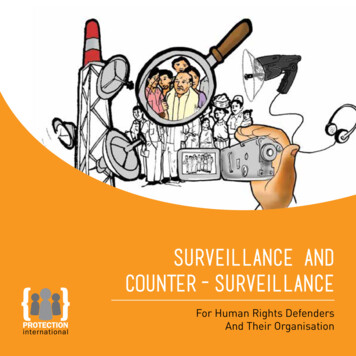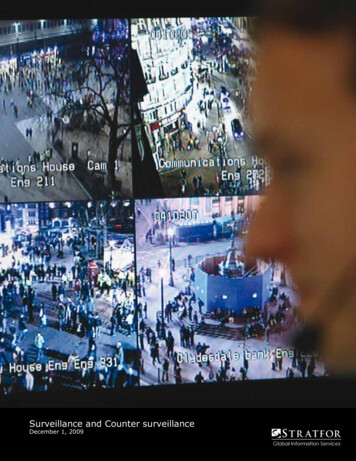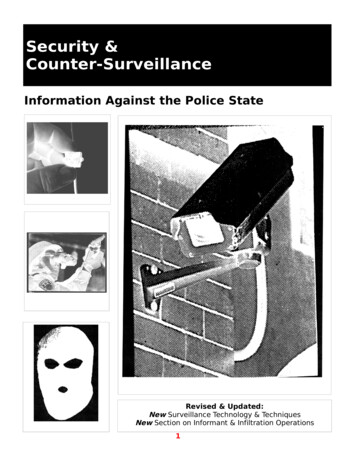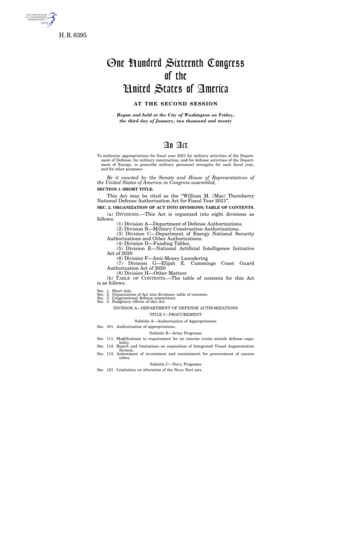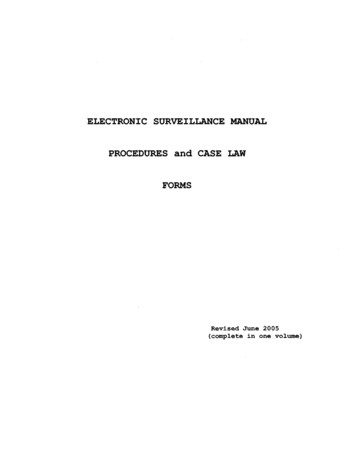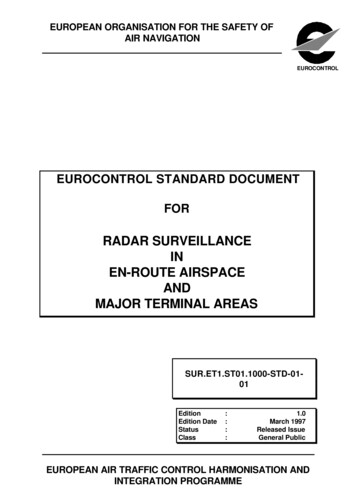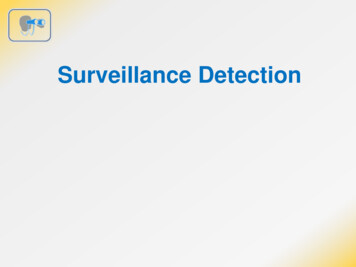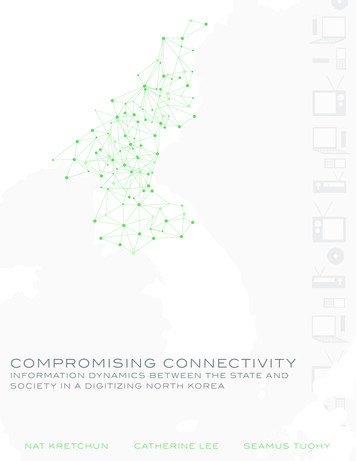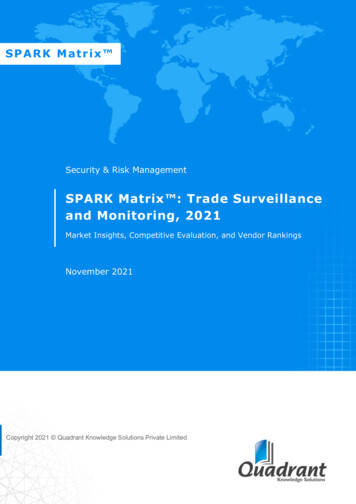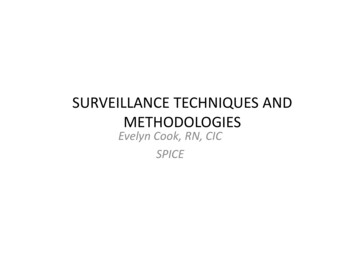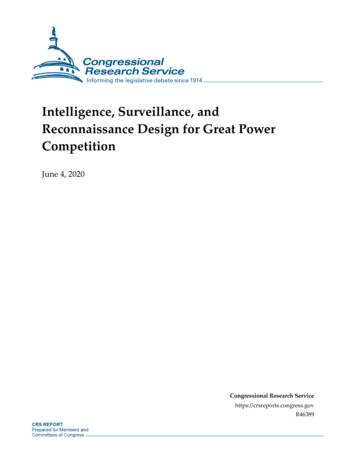
Transcription
Intelligence, Surveillance, andReconnaissance Design for Great PowerCompetitionJune 4, 2020Congressional Research Servicehttps://crsreports.congress.govR46389
SUMMARYIntelligence, Surveillance, and ReconnaissanceDesign for Great Power CompetitionR46389June 4, 2020Nishawn S. SmaghThe U.S. military could suffer unacceptably high casualties and struggle to win, or perhaps lose,National Defense Fellowa war against China or Russia. This implication by the National Defense Strategy Commissionstands in contrast to the past several decades during which the U.S. possessed military powerwithout equal. Great power competition has returned, marked by Chinese and Russian malignactivities occurring below the threshold of armed conflict, an area of competition called the greyzone, while they simultaneously advance warfighting capabilities with increased lethality, range, and speed. The result is thepotentially significant erosion of the military advantage possessed by the United States.A key capability to ensure the U.S. military maintains its dominance is in its intelligence, surveillance, and reconnaissance(ISR) assets. The House and Senate Armed Services Committees have both taken an increasing interest in U.S. military ISRcapabilities vis-à-vis China and Russia. The House has emphasized in particular the importance of joint airborne ISRcapabilities and established a Future of Defense Task Force to review and assess U.S. defense capabilities to meet emergingthreats. The Senate has stressed command and control and both legacy and future ISR systems that can provide tactical forceswith targeting data needed to perform their mission within a highly contested environment. Most recently, the House andSenate Armed Services Committees each drafted legislation calling for appropriations to enhance military modernization, toinclude funding for ISR, in the Indo-Pacific region.Senior military leaders at the Pentagon are also rethinking modernization priorities to meet the demands of the NationalDefense Strategy (NDS), and are aiming to build a more lethal force given concerns that China and Russia may surpass theUnited States in military capability. ISR is one of their modernization priorities. More specifically, the Department ofDefense (DOD) aims to connect ISR sensors across all warfighting domains (space, air, land, sea, and cyber) directly withcommanders and weapon systems, sharing data at an accelerated speed. This will enable U.S. and allied forces to outthink,outpace, and outmaneuver its adversaries. Congress may consider whether the DOD-wide modernization programs andbudget requests for developing advanced sensing capabilities and connecting those sensors to shooters, match the strategiesidentified in the National Security Strategy (NSS) and NDS.The current DOD ISR enterprise does not yet possess the readiness to effectively support operations in the grey zone orsupport combat operations in a highly contested environment, according to senior DOD ISR leaders. To meet the demands ofthe new global strategic environment, the DOD ISR enterprise intends to shift from a manpower-intensive force optimizedfor operations within a permissive environment to an automation-intensive force capable of defeating a peer adversary withina highly contested environment. To achieve operational success within a high threat environment, the Services have indicatedthey would like to invest in resilient and collaborative ISR capabilities that enhance situational awareness, aid rapiddecisionmaking, and reliably find, fix, and target elusive targets deep within enemy territory. The objective is to generate aninformation advantage for U.S. military forces, which is paramount to effective operations both in the grey zone and highlycontested environments.To achieve an information advantage, each military service has highlighted a number of initiatives unique to their specificprimary missions and in support of creating an all-domain sensing and sense-making capability. In other words, the aim ofthe future DOD ISR enterprise is to gain access to data from multiple domains (space, air, land, sea, and cyber); make rapidsense of that data; securely deliver that data to weapons, weapon systems, and commanders; and possess a workforce that canexecute its mission in competition and combat, at a pace greater than the enemy. However, each service faces significantchallenges with harnessing the exponential growth in data to realize the potential of disruptive technology and shaping thefuture workforce to employ these warfighting capabilities.This report offers Congress a conceptual framework for understanding unclassified DOD ISR modernization initiatives forgreat power competition. Congressional interests include funding levels, strategy, plans, and programs relative to militaryISR investments for the new global strategic environment as defined in the NSS and NDS. Congress’s decisions on theseissues could have significant implications on the U.S. military’s competitive advantage versus China and Russia and itsability to compete, deter, and win in this environment.Congressional Research Service
ISR Design for Great Power CompetitionContentsIntroduction: Evolution into Great Power Competition . 1What Is Intelligence, Surveillance, and Reconnaissance (ISR)? . 1ISR Roles and Responsibilities . 3Intelligence in Military Operations . 4Scoping the Challenge . 5Grey Zone . 6Highly Contested Environment . 7Rethinking Military Modernization Priorities . 8Connecting Sensors to Shooters . 9Joint All Domain Operations (JADO) . 9Joint All Domain Command and Control . 10Congressional Actions on ISR . 11ISR Design for Great Power Competition . 13Air Force . 14Next Generation ISR Dominance Flight Plan . 14ISR Rebalance. 14Future Capability Investments . 15Collaborative Sensing Grid . 17Air Force Distributed Common Ground System . 17Information Warfare . 18Other Views . 18Space Force . 19Space Situational Awareness . 19Ballistic Missile Warning System . 20Army . 20ISR Task Force . 21Space . 22Multi-Domain Sensor System . 22Terrestrial Layer System . 23Tactical Intelligence Targeting Access Node . 23Distributed Common Ground System—Army . 23Science and Technology Focus . 24Other Views . 24Navy . 25Information Warfare . 25Airborne Platforms. 25Surface Vessels. 25Data Fusion Technology . 26Human Capital . 27Other Views . 27Marine Corps. 28Expeditionary Advanced Base Operations . 28Marine Corps ISR Enterprise . 28Airborne Platforms. 29Surface Vessels. 29Data Fusion Technology . 29Congressional Research Service
ISR Design for Great Power CompetitionInformation Warfare . 30Operationalizing ISR for Great Power Competition . 30Data . 30DOD Data Strategy . 31Challenges with Data Formats . 31Keeping Pace with Data . 32Disruptive Technology . 33Human-Machine Teaming. 34Cloud Technology . 35Human Capital . 35Shaping the Future ISR Force . 35Partnering with Industry and Academia . 36Issues for Congress . 36FiguresFigure 1. Array of Multi-domain ISR Capabilities . 3Figure 2. Joint Intelligence Process . 4Figure 3. China Anti-Access/Area Denial Defensive Layers . 8Figure 4. Joint All Domain Command and Control. 11Figure 5. Air Force ISR Rebalance . 15Figure 6. Army Cross-Functional Teams. 21Figure 7. Maritime Security and Operational Environment . 27Figure 8. How Much Data Is Generated Every Minute? . 33ContactsAuthor Information. 37Congressional Research Service
ISR Design for Great Power CompetitionIntroduction: Evolution into GreatPower CompetitionThe terror attacks on September 11, 2001, followed nearly a decade without major conflict andpushed the U.S. military into counter-terror (CT) and counterinsurgency (COIN) operationsaimed at defeating enemies in Afghanistan, Iraq, and other austere locations. However, the 2017National Security Strategy (NSS) and the 2018 National Defense Strategy (NDS) note that theglobal strategic environment has changed, and that it is now characterized primarily bycompetition between the United States and an ascending China, as well as a reemerging Russia.Importantly, this competition is marked by Chinese and Russian malign activities occurringbelow the threshold of armed conflict while they and other competitors have simultaneouslyfielded warfighting capabilities with increased lethality, range, and speed. This combination ofactions and capabilities, according to the National Defense Strategy Commission, hassignificantly eroded the military advantage possessed by the United States since the end of WorldWar II in the Pacific and the fall of the Soviet Union in 1991.1 An operationally importantcapability associated with this advantage has been U.S. intelligence, surveillance, andreconnaissance (ISR) assets.What Is Intelligence, Surveillance, andReconnaissance (ISR)?“The world is not getting any safer, and espionage remains our first line of defense.”General Michael V. Hayden2ISR is a military operation intended to help “decision makers anticipate change, mitigate risk, andshape outcomes.”3 The U.S. Department of Defense (DOD) defines ISR as “an integratedoperations and intelligence activity that synchronizes and integrates the planning and operation ofsensors, assets, and processing, exploitation, and dissemination systems in direct support ofcurrent and future operations.”4 It is at the intersection between military planning, operations, andassessment where intelligence is the product of surveillance and reconnaissance operations.1National Defense Strategy Commission, Providing for the Common Defense: The Assessment and Recommendationsof the National Defense Strategy Commission, 2018, December 12, 2019, at roviding-for-the-common-defense.pdf. The commission was created pursuant to the National DefenseAuthorization Act of 2017 to examine and make recommendations with respect to the national defense strategy of theUnited States. More specifically, the commission was charged with formally reviewing the National Defense Strategy(NDS) released by the Department of Defense (DOD) in January 2018, as well as assessing and offering its views onthe broad range of issues that informed that strategy. The commission was tasked with reporting its findings to thePresident, Secretary of Defense, Committee on Armed Services of the House of Representatives, and Committee onArmed Services of the Senate.2 Hayden, Michael V., Playing to the Edge, Penguin Books, February 23, 2016.3 Brown, Jason, Strategy for Intelligence, Surveillance, and Reconnaissance, Air University Press, 2014.4 DOD Dictionary of Military and Associated Terms, at pubs/dictionary.pdf.Congressional Research Service1
ISR Design for Great Power CompetitionIntelligence. The product resulting from the collection, processing, integration, evaluation,analysis, and interpretation of available information concerning foreign nations, hostile orpotentially hostile forces or elements, or areas of actual or potential operations.5Surveillance. The systematic observation of aerospace, cyberspace, surface, or subsurface areas,places, persons, or things by visual, aural, electronic, photographic, or other means.6Reconnaissance. A mission undertaken to obtain, by visual observation or other detectionmethods, information about the activities and resources of an enemy or adversary, or to securedata concerning the meteorological, hydrographic, or geographic characteristics of a particulararea.7ISR does not imply that the U.S. military senses all activity within a given battlespace. It involvesusing a wide-array of platforms, sensors, and analytic capacity to create an awareness ofadversary capabilities, dispositions, and likely intentions. This awareness, resulting from analysis,is then used by commanders to exercise Command and Control (C2) and decide appropriatemeasures to utilize available military capabilities.5Ibid.Ibid.7 Ibid.6Congressional Research Service2
ISR Design for Great Power CompetitionFigure 1. Array of Multi-domain ISR CapabilitiesData Network, Platforms, Sensors, and OperatorsSource: U.S. Air Force.Notes: A wide variety of platforms (satellites, aircraft, ships, humans, etc.) and sensors (imagery,communications, acoustics, etc.) collect, analyze, and share data, information, and intelligence across multiplewarfighting domains. The focus of ISR is on answering a commander’s information needs, such as identifying andlocating adversary activity and intentions within a given battlespace. Specific intelligence disciplines include butare not limited to Signals Intelligence (SIGINT), Geospatial Intelligence (GEOINT), Measurement and SignaturesIntelligence (MASINT), Publicly Available Information (PAI), and Human Intelligence (HUMINT).ISR Roles and ResponsibilitiesAccording to joint military doctrine, the primary role of intelligence is to provide information andassessments to facilitate mission accomplishment.8 For instance, targeting an adversary’s longrange missiles is, of course, much easier when U.S. military commanders know where themissiles are. ISR aims to inform commanders to enable decisionmaking, support militaryplanning by anticipating adversary actions and defining the operational environment, warnfriendly forces of threats, support deceptive techniques and counter adversary deception, identify8Joint Chiefs of Staff, Joint Publication 2-0 Joint Intelligence, October 22, 2013.Congressional Research Service3
ISR Design for Great Power Competitionadversary vulnerabilities, hold targets at risk of being attacked, and assess combat effectiveness.9These roles and responsibilities are accomplished through a detailed joint intelligence process thatfacilitates an understanding of the wide variety of intelligence operations and theirinterrelationships.Figure 2. Joint Intelligence ProcessSource: CRS Adaptation from Joint Publication 2-01, Joint and National Intelligence Support to MilitaryOperations, July 5, 2017.Intelligence in Military OperationsThe most important role of intelligence in military operations is to provide commanders withanalysis of key aspects of the operational environment to assist them in their decisionmakingprocess. Using a wide variety of capabilities ranging from above the earth’s atmosphere to belowthe surface of the ocean, ISR sensors collect data on a given area of operations or battlespace insupport of a commander’s information needs. Such needs may include the location of adversaryforces, their warfighting capability, and their intentions. The collected data resulting frommultiple sources are then analyzed, largely by human operators with support from artificialintelligence, and transformed into information. This information creates a narrative on observedactivity within the battlespace. Analysts then derive meaning from information, resulting inintelligence and generating a picture of adversary activity that answers the commander’sinformation needs and ultimately drives decisionmaking. Furthermore, during the execution ofreal-time combat operations and in accordance with the direction provided by a commandingofficer, ISR provides both targeting data for weapon systems to engage enemy forces and threatdata to protect forces.The following is a simplified, hypothetical example of how ISR operations are conducted insupport of a commander’s objectives. In order to gain control of the airspace within anoperational environment (air superiority), a commander determines the operational objective to9Ibid.Congressional Research Service4
ISR Design for Great Power Competitionfind, fix, and target enemy air defense systems. Via mission analysis, analysts determine that anadversary mobile air defense system remains un-located, posing a direct threat to aircraft andtheir achieving air superiority. ISR operators at Command and Control (C2) centers synchronizeavailable intelligence capabilities, assigning collection tasks to appropriate platforms and sensorswhile also tasking analytic nodes to rapidly make sense of collected data and generate intelligencein support of the commander’s requirement to identify and locate the missing air defense system.Platform operators and analysts then collaboratively plan how best to accomplish thecommander’s intent. The operation begins, and an array of ISR assets, either operating in a singledomain or multiple domains, work together to find and fix the missing air defense system. ASIGINT sensor collects data on the air defense system, finding the general location where it islocated. Confirming the data, an analyst then shares that data with the C2 center and other ISRsensors, queuing a full-motion video (FMV) sensor to image the location. Within the FMV fieldof view, imagery analysts fix the air defense system, noting its specific geographic location.Armed with confirmation of the identity and location of the air defense system, the C2 centertasks a strike aircraft to target the air defense system. A strike is conducted, and additional ISRassets are tasked to conduct a damage assessment, confirming that the air defense system nolonger poses a threat to achieving air superiority.This process, largely operating at human-speed, can occur simultaneously or sequentially, takingfrom several minutes to days to accomplish. The U.S. military’s goal for the future is to conductthis process at machine speed, an accelerated pace achieved by employing artificial intelligenceand cloud computing. At machine speed, this process can be conducted in seconds to single digitminutes, enabling U.S. and allied forces to outthink, outpace, and outmaneuver its adversary onthe battlefield.Scoping the ChallengeThe 2017 NSS stated that China and Russia both seek to assert their influence across the globewith the intent to undermine and supplant American leadership by cleverly operating below thethreshold of armed conflict, an area of global competition former Chairman of the Joint Chiefs ofStaff, General Joseph Dunford, identified as the grey zone.10 Recognizing that U.S. nationalsecurity interests had evolved from terrorism to strategic competition, the 2018 NDS focusedDOD’s strategy to compete with and deter U.S. great power adversaries by remaining prepared todecisively win a war.11 In support of both grey zone competition and combat operations within ahighly contested environment, the challenge for the DOD ISR enterprise is twofold. The firstchallenge is to develop and field capabilities that can endure a degradation in mission capacity yetremain operational, facilitating collaboration among multiple platforms, sensors, and disruptivetechnologies. Second, the ISR enterprise must overcome challenges in collecting, analyzing, andsharing an exponential growth in data at machine speed.10General Joseph Dunford, Chairman of the Joint Chiefs of Staff, in testimony before the U.S. Congress, SenateCommittee on Armed Services, The Fiscal Year 2020 National Defense Authorization Budget Request from theDepartment of Defense, 116th Cong., 1st sess., March 14, 2019.11 Department of Defense, “Summary of the 2018 National Defense Strategy of The United States of America;Sharpening the American Military’s Competitive Edge,” at onal Research Service5
ISR Design for Great Power CompetitionGrey ZoneThen-Chairman Dunford testified that China and Russia innovatively use the grey zone—thecompetitive space that resides between peace and war—to pursue strategic gains withoutprovoking a conventional conflict and therefore mitigating the United States’ competitive militaryadvantage.12 For example, China’s broad lineup of actions include military intimidation,paramilitary activities, information operations, industrial and academic espionage, and economiccoercion.13 Russia is also an active participant in the grey zone, responsible for employing“military intimidation, weaponization of social media, information and cyber warfare andfunding proxy groups and political organizations hostile to Western institutions.”14 GeneralDunford also surmised that the collective sum of peer adversary actions in the grey zoneundermine U.S. alliances and partnerships and the health and stability of democracies, whileimposing gradual, and potentially irrevocable, losses on the U.S. strategic position around theglobe.15Military ISR serves a significant role in supporting grey zone operations. An array of spysatellites, surveillance aircraft and ships, and ground-based collection and analysis centersprovide early warning to deny an adversary the opportunity to conduct a surprise strategic attackagainst the U.S. and its allies, or to confirm incidents involving adversary military intimidation orparamilitary activities. For example, the Chinese Navy shadows and harasses neighbor-statefishing vessels operating in international waters, and Russia has deployed paramilitary units toLibya in support of forces opposing the internationally recognized Libyan government.16 It alsosupports readiness via war plan development conducted by U.S. combatant commands andinforms development and acquisition of future weapon systems intended to ensure continued U.S.military competitive advantages. Military ISR also complements national intelligence gained bythe U.S. Intelligence Community in support of national level policy. Fulfilling these missionshelps ensure the U.S. possesses an information advantage over an opposing force and helpsstrengthen military alliances and partnerships via intelligence sharing and therefore generatingtransparency and shared awareness on malign adversary actions.However, grey zone operations may be an area that the U.S. military finds itself ill-prepared tocompete effectively in as it attempts to transform stove-piped ISR operations, challenged with12General Dunford, in testimony before the U.S. Congress, Senate Committee on Armed Services, March 14, 2019,described the grey zone as possessing five distinct characteristics: “political influence, economic coercion, use of cyber,information operations, and then military posture.” General Dunford continued, declaring that within the militarystrategy the “competition in the grey zone is really for our partners,” where the adversary seeks “to undermine thecredibility of our alliances and partnerships,” and therefore it is “critical for us to overcome in the information space,overcome in cyber capabilities, and then our military posture the erosion of that relationship we have with our allies.”13 Morris, Lyle J., Mazzar, Michael J., Hornung, Jeffrey W., Pezard, Stephanie, Binnendijk, Anika, Kepe, Marta,“Gaining Competitive Advantage in the Gray Zone,” RAND Corporation, 2019, at h reports/RR2900/RR2942/RAND RR2942.pdf.14 Ibid.15 General Joseph Dunford, Chairman of the Joint Chiefs of Staff, in testimony before the U.S. Congress, SenateCommittee on Armed Services, The Fiscal Year 2020 National Defense Authorization Budget Request from theDepartment of Defense, 116th Cong., 1st sess., March 14, 2019.16 Grady, John, “DOD Official: U.S. Committed to Countering Chinese Military Intimidation in South East Asia,”USNI News, August 7, 2018, at south-east-asia and Department of Defense, “R
Intelligence, Surveillance, and Reconnaissance Design for Great Power Competition June 4, 2020 Congressional Research Service https://crsreports.congress.gov . support deceptive techniques and counter adversary deception, identify 8 Joint Chiefs of Staff, Jo
